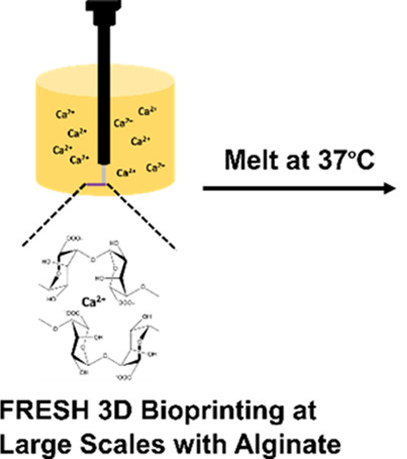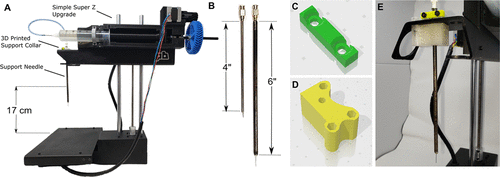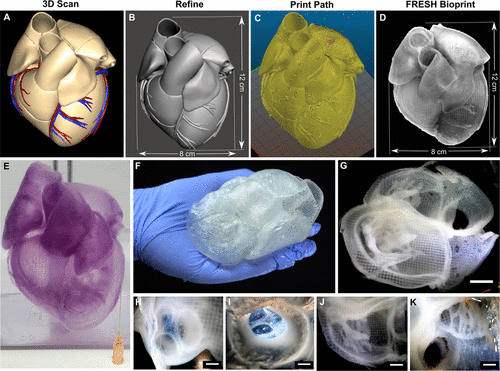After two years of research, bioprinting expert Adam Feinberg and his team created the first full-size model of an adult human heart using their Freeform Reversible Embedding of Suspended Hydrogels (FRESH) technique. The lifelike model made from patient-derived magnetic resonance imaging (MRI) data sets was printed in four days on a specially built low-cost printer platform using alginate bioinks. The team’s latest findings were published in the journal ACS Biomaterials Science and Engineering and suggest that the bioprinted cardiac model not only mimics the realistic feel, elasticity, and mechanical properties of cardiac tissue, but is also durable enough to handle, suture, and perfuse, making it an ideal tool for surgical simulation and training.
According to the paper co-authors, in its current state, the full-size adult cardiac scaffold represents an important step toward fabricating realistic feeling, organ size cardiac tissues for surgeons to practice on. It also lays the groundwork toward full-size organ printing for tissue engineering and cardiac regenerative medicine. Moreover, they suggest that the advances presented in the paper titled “FRESH 3D Bioprinting a Full-Size Model of the Human Heart” could be extensible to other organ models, like the liver or kidney.

FRESH 3D bioprinting at large scales with alginate. Image courtesy of Adam Feinberg/Carnegie Mellon University
Current 3D printing techniques can produce full-size adult organ models, but the soft materials used, such as thermoplastic elastomers or silicone rubbers, lack the rigidity to stand unsupported and easily deform under the force of gravity when printed in air. This makes it difficult to fabricate large, complex structures such as the intricate internal architecture of the heart and other organs. To address this challenge and meet an unfilled demand for 3D printed soft polymers, researchers at the Feinberg lab, at Carnegie Mellon University (CMU)’s Department of Biomedical Engineering, invented the FRESH 3D bioprinting technique.
FRESH 3D printing uses a needle to inject bioink into a bath of soft hydrogel, which supports the object as it prints. Once finished, a simple application of heat causes the hydrogel to melt away, leaving only the 3D bioprinted object. The innovative technique mitigates the effects of gravity by embedding the printed material, allowing for freeform printing of delicate, unsupported structures that would otherwise immediately collapse in the air.
While Feinberg’s lab had proven both the versatility and the fidelity of the FRESH technique, the major obstacle to achieving this new milestone was printing a human heart at full scale. It required building a new 3D printer, custom made to hold a gel support bath large enough to print the heart model, as well as improvements to the syringe pump extruder and printer performance, and minor software tweaks to maintain the speed and fidelity of the print.

Modifications made to original LVE printer for full-size adult human heart print. Image courtesy of Adam Feinberg/Carnegie Mellon University
The team chose a biomaterial derived from seaweed called alginate as the bioink, due to its low cost, biological relevance, and tunability. Sized at approximately 8×10×12 cm3, the FRESH-printed heart could be handled outside the aqueous solution, showing the structural integrity of the print. The American Chemical Society even showcased the innovative heart construct in a recent video posted on its official YouTube.com page. In the study, the authors also explained that a cross-section of the heart revealed that fine unsupported internal features of the print were accurately recreated, including pulmonary and aortic valves as well as papillary muscle.
Beyond printing normal hearts, the FRESH approach also has the potential to fabricate structurally and mechanically realistic models of cardiac pathologies. The results showed that FRESH-printed alginate constructs can have mechanical properties that fall in the range of cardiac tissue and are much softer than the elastomers currently used for surgical models.
Major hospitals often have facilities for 3D printing models of a patient’s body to plan for the actual procedure, but these tissues and organs are typically modeled in hard plastic or rubber. Innovative models that can cut, suture, and be manipulated in ways similar to real hearts are novel, which is why this breakthrough could bring about a paradigm shift for surgeons.
“We can now build a model that not only allows for visual planning but allows for physical practice,” said Feinberg, a Professor at the Departments of Biomedical Engineering and Materials Science and Engineering at CMU. “The surgeon can manipulate it and have it actually respond like real tissue so that when they get into the operating site they’ve got an additional layer of realistic practice in that setting.”

Printing a full-size model of the adult human heart using alginate. Image courtesy of Adam Feinberg/Carnegie Mellon University
Feinberg’s immediate goal is to begin working with surgeons and clinicians to fine-tune the technique and ensure the anatomically accurate tissue models are ready for potential surgical training and planning applications in hospital settings. Lead author of the publication and bioengineering graduate student researcher at CMU, Eman Mirdamadi, indicated that while major hurdles still exist in bioprinting a full-sized functional human heart, the team managed to establish the foundational groundwork using the FRESH platform while showing immediate applications for realistic surgical simulation.
This work represents another successful demonstration of the capabilities of FRESH bioprinting, proving that large-scale bioprinting cardiac tissue constructs made from soft hydrogels can be FRESH-printed with potential surgical training applications. In the future, the team expects to work on speeding up the print process and increasing cell viability to fabricate a human heart model with a cellularized ink, something that would be impossible today using the team’s current printer design, but could pave the way for biofabrication technology that could someday repair or replace full human organs.
Subscribe to Our Email Newsletter
Stay up-to-date on all the latest news from the 3D printing industry and receive information and offers from third party vendors.
You May Also Like
New Report: Semiconductor Industry to See $1.4B in 3D Printing Revenues by 2032
“The semiconductor sector has become the most strategically significant area of global industry.” Truer words are hard to come by when it comes to the modern world, and they are...
Will Photonic-Crystal Lasers Revolutionize 3D Printing?
Powder bed fusion (PBF) for metals and polymers predominantly utilizes lasers as the primary heat source. Some directed energy deposition (DED) technologies also employ lasers, while various vat polymerization methods...
3D Printing Unpeeled: Orbex Investment, IndoMIM and HP, Ultrasonic Waves
INDO-MIM has bought three HP Metal Jet S100 printers, operating two in India and one in Texas. This is a win for HP because the company has deep experience in...
3D Printing Webinar and Event Roundup: April 21, 2024
It’s another busy week of webinars and events, starting with Hannover Messe in Germany and continuing with Metalcasting Congress, Chinaplas, TechBlick’s Innovation Festival, and more. Stratasys continues its advanced training...































